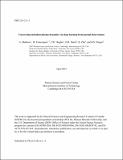Uncovering turbulent plasma dynamics via deep learning from partial observations
Author(s)
Mathews, Abhilash; Francisquez, M.; Hughes, Jerry W.; Hatch, D.R.; Zhu, B.; Rogers, B.N.; ... Show more Show less
Download21ja011_full.pdf (1.613Mb)
Metadata
Show full item recordAbstract
One of the most intensely studied aspects of magnetic confinement fusion is edge plasma turbulence which is critical to reactor performance and operation. Drift-reduced Braginskii two-fluid theory has for decades been widely applied to model boundary plasmas with varying success. Towards better understanding edge turbulence in both theory and experiment, we demonstrate that a novel multi-network physics-informed deep learning framework constrained by partial differential equations can accurately learn turbulent fields consistent with the two-fluid theory from partial observations of electron pressure which is not otherwise possible using conventional equilibrium models. This technique presents a novel paradigm for the advanced design of plasma diagnostics and validation of magnetized plasma turbulence theories in challenging thermonuclear environments.
Description
Submitted for publication in Physical Review. E, Statistical physics, plasmas, fluids, and related interdisciplinary topics
Date issued
2021-04Department
Massachusetts Institute of Technology. Plasma Science and Fusion CenterJournal
Physical Review. E, Statistical physics, plasmas, fluids, and related interdisciplinary topics
Publisher
APS
Other identifiers
21ja011